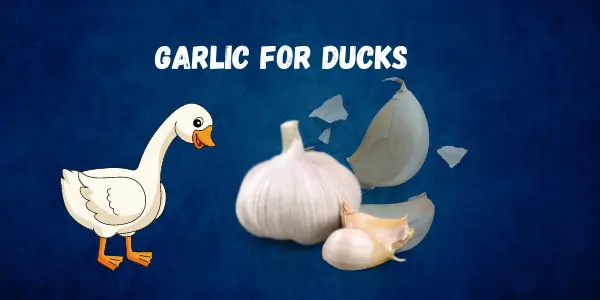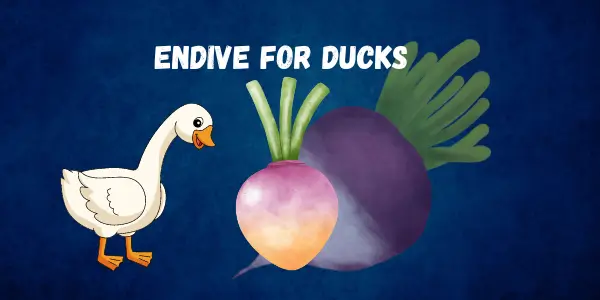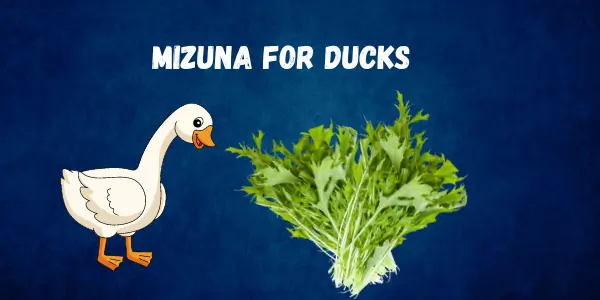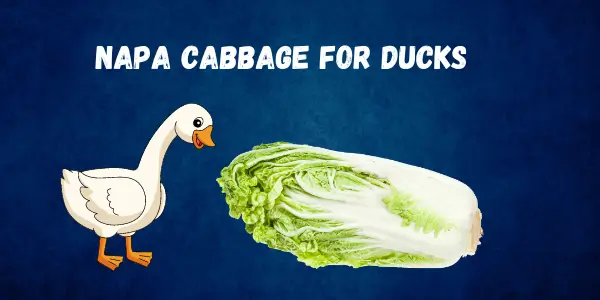Can Ducks Eat Endive Exploring Nutritional Benefits and Preparation Tips
Published: 23 Sep 2024
Can ducks eat endive? Many duck owners are curious about what foods are safe and nutritious for their feathered friends. Endive, a leafy green vegetable, can indeed be a healthy addition to a duck’s diet.
Read on to discover how endive can benefit your ducks and what you need to know before introducing it to their feeding routine.
Can Ducks Eat Endive?
When considering the diets of domestic ducks, it’s essential to understand the variety of foods that can contribute to their health and wellbeing. One such food is endive, a leafy green vegetable that often raises questions among duck owners.

Endive is not only safe for ducks but also offers numerous health benefits, making it a fantastic addition to their regular diet. Packed with essential nutrients, this vegetable can help ensure your ducks maintain good health and vitality.
Introducing endive to your ducks should be done gradually, as with any new food. It’s important to monitor how they react to this new green.
Ducks typically enjoy the slightly bitter taste of endive, and it can be a refreshing change from their usual greens. Rich in fiber, vitamins, and minerals, endive supports a healthy digestive system and contributes to overall nutritional balance.
Knowing how to incorporate endive into your ducks’ diet properly enhances their health and ensures they benefit fully from this nutritious vegetable.
What is Endive?
Endive is a leafy green vegetable that belongs to the Chicory family, which also includes foods like radicchio, escarole, and frisée.
This vegetable is known for its crisp texture and slightly bitter flavor, making it a popular choice in salads and as a garnish.
There are two main types of endive: Belgian endive, which is grown in darkness to prevent the leaves from turning green and becoming too bitter, and curly endive, which has frilly, green outer leaves and is sometimes referred to as frisée.
Nutritional Content of Endive:
Here is a table detailing the nutritional benefits of endive per 100 grams, including percentage values based on recommended daily intake:
| Nutrient | Amount per 100g | % Daily Value (DV) |
| Calories | 17 kcal | <1% |
| Total Fat | 0.2 g | <1% |
| Saturated Fat | 0.0 g | 0% |
| Cholesterol | 0 mg | 0% |
| Sodium | 22 mg | 1% |
| Total Carbohydrates | 3.4 g | 1% |
| Dietary Fiber | 3.1 g | 12% |
| Sugars | 0.25 g | <1% |
| Protein | 1.25 g | 2% |
| Vitamin D | 0 µg | 0% |
| Calcium | 52 mg | 4% |
| Iron | 0.83 mg | 5% |
| Potassium | 314 mg | 7% |
| Vitamin A | 108 µg | 12% |
| Vitamin C | 6.5 mg | 7% |
| Vitamin K | 231 µg | 192% |
| Folate (Vitamin B9) | 142 µg | 36% |
General Dietary Requirements of Ducks:
- Proteins: Ducks require a diet high in protein, especially when they are growing or laying eggs. Protein is essential for muscle development, repair, and overall growth. Ducklings, for instance, need about 20-22% protein in their diet, while adult ducks require around 16-18%.
- Fats: Fats are another crucial component of a duck’s diet, providing energy and helping to absorb vitamins. A moderate amount of fat is necessary to keep ducks healthy, but too much fat can lead to obesity.
- Carbohydrates: While not as critical as proteins or fats, carbohydrates provide ducks with additional energy. Ducks can easily digest grains and other carbohydrate sources.
- Vitamins and Minerals: Ducks need a range of vitamins and minerals for optimal health. Vitamins A, B, and D are particularly important, along with minerals like calcium, which is crucial for eggshell formation and skeletal health.
- Water: Ample access to clean, fresh water is essential for ducks, not just for hydration but also for their eating habits and maintaining their plumage.
Common Foods for Ducks:
- Grains and Seeds: These are staple foods for ducks and can include wheat, oats, rice, and smaller seeds. These should be given in moderation as part of a balanced diet.
- Vegetables: Ducks can eat a variety of vegetables, such as peas, corn, and leafy greens like lettuce and endive. These provide essential nutrients and add variety to their diet.
- Insects and Worms: Providing natural proteins, insects like worms, snails, and small crustaceans are excellent for ducks, especially for free-range or wild ducks.
- Commercial Duck Feed: This is formulated to provide a balanced diet with the appropriate nutrients and is especially recommended to ensure all dietary needs are met.
- Supplements: Depending on their environment and the quality of their primary diet, ducks may require additional supplements, particularly for calcium and other minerals.
Potential Benefits and Risks:
| Potential Benefits and Risks: |
|---|
|
Endive can be a healthy addition to a duck’s diet when offered in moderation. Below are the potential benefits and risks associated with feeding endive to ducks.
|
Other Vegetable Ducks Eat:
Risks of Feeding Endive to Ducks:
| Risks of Feeding Endive to Ducks: |
|---|
|
How to Safely Introduce Endive to a Duck’s Diet:
Introducing new foods to a duck’s diet, such as endive, should be done cautiously to avoid digestive issues and to ensure that the ducks are receiving a balanced diet. Here’s how you can safely introduce endive into your ducks’ feeding routine.
Recommended Preparation Methods:
- Washing Thoroughly: Always start by thoroughly washing the endive to remove any pesticides, dirt, or potential bacteria. This is crucial for maintaining the health and safety of your ducks.
- Chopping: Cut the endive into smaller pieces to prevent choking hazards and to make it easier for ducks to eat. Young ducklings especially benefit from finely chopped greens.
- Mixing with Other Foods: Introduce endive mixed with other familiar foods to help the ducks adjust to the new flavor and texture. This can include mixing it with their regular feed, other greens they are used to, or grains.
- Offering Raw: Serve endive raw, as cooking may reduce some of its nutritional benefits, such as vitamin content.
- Gradual Introduction: Start with small amounts to see how your ducks react to endive both in terms of taste preference and digestive response.
Portion Sizes and Frequency:
- Portion Size: Initially, a small handful of chopped endive for each duck is sufficient to gauge their reaction. Depending on their size, age, and dietary needs, you can adjust this amount.
- Frequency: Begin by offering endive once or twice a week. Monitor their health and acceptance, and if they respond well, you can gradually make it a more regular part of their diet.
- Dietary Balance: Ensure that endive does not replace essential components of their diet. It should complement a balanced diet that includes a variety of grains, other vegetables, and adequate protein sources, particularly for ducklings and laying ducks.
- Observe and Adjust: Pay attention to any changes in your ducks’ health or behavior. If there are any signs of digestive upset or refusal to eat, adjust the amount and frequency accordingly.
FAQs on Feeding Endive to Ducks:
Can baby ducks eat endive?
Yes, baby ducks can eat endive, but it should be finely chopped to prevent choking and introduced gradually into their diet to ensure they can digest it properly.
What types of ducks can eat endive?
All types of domestic ducks can eat endive, including popular breeds like Pekin, Mallard, and Muscovy. It’s a suitable addition to both free-range and confined ducks’ diets.
What types of endive can ducks eat?
Ducks can eat various types of endive, including Belgian endive and curly endive (frisée). Each type should be washed and chopped appropriately before feeding.
How often can I feed my ducks endive?
You can feed endive to your ducks about 2-3 times a week as part of a balanced diet. Monitor their health and adjust the frequency based on their specific dietary needs and preferences.
Is endive safe for all duck breeds?
Yes, endive is generally safe for all breeds of domestic ducks when prepared properly and fed in moderation. It’s always a good idea to start with small quantities to see how your ducks react.
Can ducks eat endive stems along with the leaves?
Ducks can eat both the leaves and the stems of endive. However, ensure the stems are chopped into manageable pieces to prevent any risk of choking.
Do I need to supplement my ducks’ diet if I feed them endive?
While endive is nutritious, it should not be the sole component of your ducks’ diet. It’s best used as a supplement to a well-rounded diet that includes a variety of grains, other vegetables, and protein sources.
Can endive replace lettuce in my ducks’ diet?
Endive can be a good alternative to lettuce in a duck’s diet, offering similar hydration benefits but with higher nutritional content, particularly in vitamins and fiber.
How should I store endive for duck feeding?
Store endive in a cool, dry place or in the refrigerator to keep it fresh. Wash and chop it just before feeding to maintain its nutritional value and prevent spoilage.
What are the signs that my ducks are not tolerating endive well?
Signs to watch for include reduced appetite, digestive upset, or changes in droppings. If you notice any of these issues, reduce the amount of endive or eliminate it from their diet and consult a veterinarian.
Conclusion:
Endive offers a nutritious addition to a duck’s diet, being rich in fiber, vitamins, and minerals. When introducing endive, it’s important to do so carefully and in moderation to ensure it suits the digestive needs of the ducks without overshadowing other essential dietary components.
Always observe your ducks’ health and preferences when adding new foods to their diet.

- Be Respectful
- Stay Relevant
- Stay Positive
- True Feedback
- Encourage Discussion
- Avoid Spamming
- No Fake News
- Don't Copy-Paste
- No Personal Attacks

- Be Respectful
- Stay Relevant
- Stay Positive
- True Feedback
- Encourage Discussion
- Avoid Spamming
- No Fake News
- Don't Copy-Paste
- No Personal Attacks





